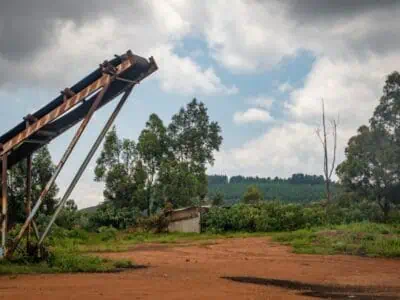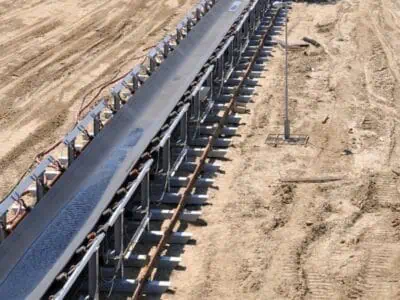In the construction, landscaping, and waste industries, downtime isn’t just inconvenient—it’s costly. Whether you’re moving demolition rubble, soil, timber offcuts, or scrap metal, the conveyor belt material you rely on needs to take a beating and keep moving. A conveyor belt that wears out too fast, slips under pressure, or can’t handle rough or heavy loads becomes a constant source of frustration.
Choosing the right material is more than a maintenance decision—it’s a question of efficiency, site safety, and job flow. This guide breaks down what goes wrong when the wrong belt is in use, why material selection varies depending on application, and how you can make smarter, longer-lasting choices for your next conveyor setup.
What problems can arise from poor belt conveyor material?
If you’ve ever lost hours on-site due to a belt splitting, slipping or jamming, you already know how the wrong belt can throw a spanner in the works. The most common issues include:
- Premature cracking or wear occurs when belts can’t handle abrasive loads like rock, concrete, or rubble.
- Unreliable load tracking, especially when belts stretch unevenly or lack proper grip.
- Material buildup or sticking on belts that aren’t suited for wet or sticky loads.
- Higher fuel or power use, especially on portable plants, occurs when belts create excessive drag.
- Breakdowns that lead to delays, missed deliveries, and frustrated clients.
For example, using a lightweight belt for moving bricks or timber waste across uneven ground is a recipe for constant stops. In waste management yards, if the belt material doesn’t resist oils or leachate, degradation kicks in fast. You’re better off matching your setup to your materials by reviewing the industrial conveyor surface construction before fitting or upgrading your system.
Why do industries use different belt conveyor materials?
A belt that handles dry mulch in a landscaping yard isn’t going to cut it in a concrete recycling plant. That’s why material selection is so critical. Here’s how needs differ across the sectors:
- Construction and demolition sites deal with jagged debris—high-strength rubber belts are a must.
- Landscaping operations often use lightweight, flexible belts to move soil, bark, and turf.
- Waste management requires chemical-resistant belts that can handle everything from e-waste to liquids.
- Renovation clean-up may need compact, portable conveyors with belts that resist puncture and tear.
- Remedial works—like waterproofing and concrete repair—often call for moisture-tolerant materials.
Each job site throws up different challenges: exposure to weather, sharp material edges, corrosive liquids, or fine dust. That’s why choosing conveyor belt specs tailored to the job at hand helps avoid unnecessary wear, safety risks, or replacement delays.
Are there risks in selecting unsuitable belt conveyor materials?
Absolutely—and not just in terms of breakdowns. The wrong belt can compromise site safety and damage other parts of your conveyor system. Specific risks include:
- Roller damage from belts that stretch, bunch, or tear.
- Safety hazards occur when belts snap or jam mid-operation.
- Increased injury risk if slipping belts drop or scatter loads.
- Corrosion or contamination occurs when belts degrade from exposure to liquids or chemicals.
- Reduced output occurs when friction or drag slows down the load movement.

In sectors where time equals money, even a one-day delay can derail schedules. That’s why understanding conveyor material differences isn’t a nice-to-know-it—it’s part of smart planning. Get it right early, and you’ll avoid costly patches and panicked downtime later.
How do you choose the right belt conveyor material?
For most trade-based businesses, time on tools is more important than time reading spec sheets. But when it comes to conveyor belt materials, a few smart checks up front will save you hassle long-term:
- Think about what’s being moved—Loose rubble, wet sand, green waste, broken tiles?
- Look at the site conditions—Hot, damp, exposed to weather or chemicals?
- Consider how often it runs—24/7 plant, or once a day on small sites?
- Check your load volume and belt speed—Heavy, slow loads need different support than light, fast ones.
- Know how often you can afford downtime—Some belts require regular maintenance, others don’t.

Material strength, grip, and durability should always align with proven conveyor systems for industrial use, especially when handling unpredictable loads in rough conditions. When unsure, your safest bet is focusing on the safe use of conveyors in the workplace, ensuring materials can tolerate your specific worksite pressures. Not only does this cut back on breakdowns, it also helps you meet any environmental or workplace safety regs without a second thought.
What makes some belt conveyor materials more durable?
Durability isn’t about bulk—it’s about how a belt handles wear, heat, movement, and exposure over time. Here’s how common materials compare:
| Material | Abrasion Resistance | Heat Resistance | Chemical Resistance | Flexibility |
| PVC | Medium | Low | High | High |
| Rubber | High | Medium | Moderate | Medium |
| Polyurethane | High | Medium | High | High |
| Stainless Steel | Very High | Very High | Very High | Low |
Heavier-duty belts often mean fewer repairs, better handling of tough jobs, and longer gaps between replacements. If your work includes abrasive materials or harsh environments, spending a bit more on durability usually pays off.
Is investing in better belt materials worth it?
On the tools, every delay chips away at your margins. That’s why a reliable conveyor belt is worth its weight. Here’s what a quality belt delivers:
- Less downtime, especially under tough loads.
- Fewer site injuries or failures, thanks to higher load integrity.
- Reduced maintenance, meaning more time for the actual job.
- Longer lifespan, which saves you money throughout the year.
- Smooth site operations, with less fiddling and fewer stops.
If you’re constantly replacing belts or battling with gear that won’t stay lined up, it’s a sign your material choice isn’t up to scratch. Instead of chasing quick fixes, think long-term. You might find it’s cheaper in the end.
Final thoughts on choosing belt conveyor material
If you’re moving materials on any kind of site—demo, remedial, landscaping, or clean-up—the conveyor belt needs to handle the hard work. There’s no point saving a few bucks upfront if it means more breakdowns, more risk, and more lost time. The right material will hold up under load, resist damage, and keep your team moving without constant patch jobs.
If you’re not sure what material suits your job setup, see how Conveying & Hoisting Solutions can help by walking you through options tailored for construction and waste handling.




